Campdrafting has come a long way since bush stockmen used to challenge each other around their campsite. This exciting horse sport is now being showcased in the World Championship Gold Buckle Campdraft at none other than Willinga Park.
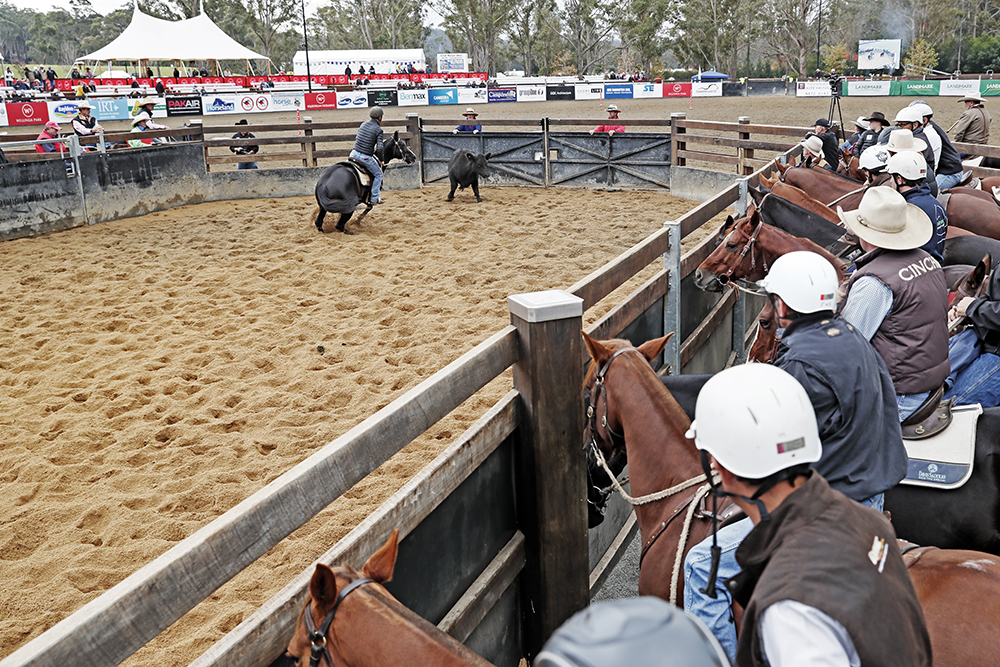
“It grew out of the bush… .
and remains the passion of the bush.”
Campdrafting is uniquely Australian. Along with polocrosse and Aussie rules footy, it is one of a few sports created in Australia. Like most sports, it originated from rivalry. Australian stockmen who spent days in the outback mustering cattle in the late 1800s would still be fired up when they returned to their camp and argue over who was the best at sorting, or drafting, the semi-wild beasts. It wasn’t so much who was the better rider — it was also who had the better camp horse. Two great minds had to think alike.
So, after a full day’s work, stockmen would often compete around the camp before sundown, sometimes, apparently, with money at stake. Riding skill was of the utmost importance but the cattle horses needed that instinct to want to work with the cattle to control their direction. It started with pitting each other to see who could cut a beast out of a mob in the yards, then control it without it returning to the mob. The horses were bred for stamina, strength and agility and, in time, the best of the best of these bred horses became what is known today as the Stock Horse.
Warwick, a modest but storied town south-east of Brisbane, is regarded as the home of campdrafting. But while the Warwick Gold Cup has long been the most sought-after trophy in the sport, the title of birthplace of campdrafting must go to Tenterfield, a small town some 115km further south. Tenterfield is where in 1885 the first official cattle drafting competition was held, along with a set of rules drawn up by local cattleman, Clarence W. Smith of Boorook Station. Smith’s rules soon became accepted by cattle drafting competitors wherever an event was held, and those rules still form the foundation of campdraft competition judging today.
It grew out of the bush, was developed in the bush and remains the passion of the bush; campdfrafting now binds families, country towns and country people together. As a fast-growing equestrian sport – some say the fastest – the rules have become quite refined these days.
All competitors now ride under the National Campdrafting Council of Australia (NCCA) rules. In a campdrafting competition, a mounted rider moves into a small yard and selects one beast from a small mob of cattle. He or she then proceeds to move the beast towards the camp opening, which is blocked by two gates with men holding them shut. The mounted rider blocks and turns the beast several times across the face of the camp to demonstrate the horse’s ability to hold the beast away from the mob. When the rider feels that they have shown the judge enough, he or she calls for the gates to be opened and they move out into a larger arena to complete the course — the run.
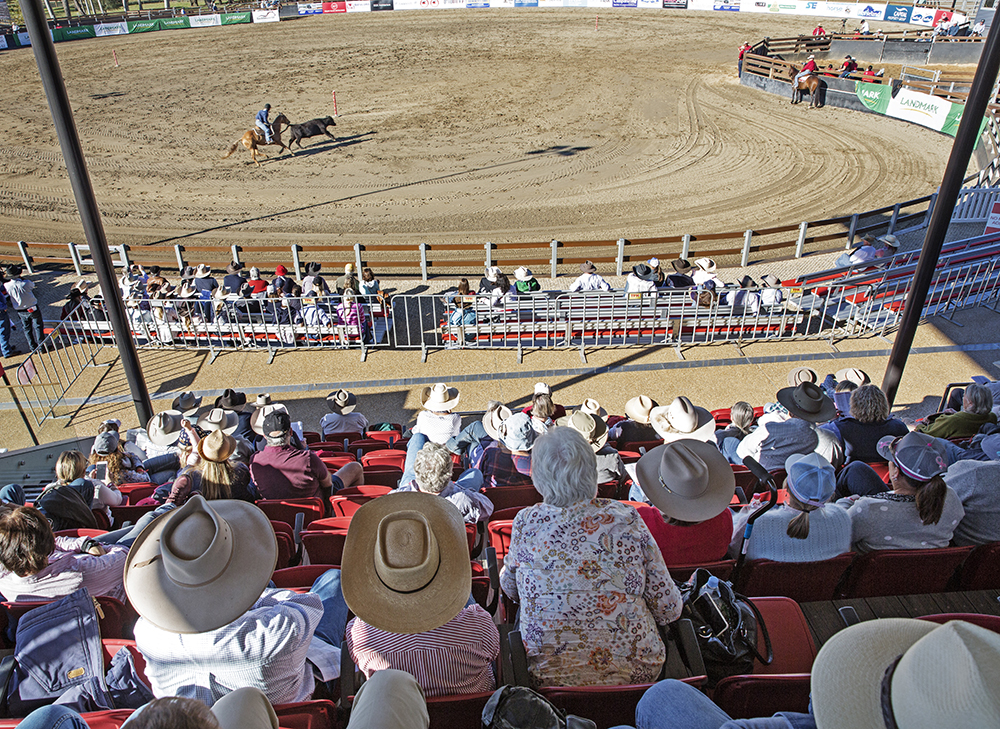
“Campdrafts cater for all age groups
of boys, girls, men and women.”

“The prestige associated with a win
in a large campdrafting competition is
invaluable to the owner of the horse.”
The course consists of two pegs set apart, one on the left and one on the right directly out from the camp gate. Some distance from these pegs are another two pegs that are set close together and represent the gate. The judge declares at the beginning of competition whether the course is left-hand or right-hand. If the course is right-hand, the rider must complete a circle around the right-hand peg first then change over in the middle and complete a circle around the left-hand peg. The rider then drives the beast out behind the gate and pushes it through the gate. At this point, the rider has finished the run, which must be completed in under 40 seconds.
The score is out of 100 points. The “cut-out” is worth a maximum of 26 points, awarded by judges who assess the way horse and rider control the beast. The run has a maximum of 4 points (2 for rounding the first peg then 1 for the second and 1 for the gate). There are a further possible 70 points for “horse work”, which can only be gained if the combination rounds the first peg. This score is given by the judge of the draft and is determined by their opinion of the horsemanship and control. Smooth turns, attitude and agility of the horse, and its keen eye for instinctive cattle control combined with that of the rider, and communication between horse, rider and beast are what they look for. A good campdrafter is not just a fine horseman but one who has the cattle skills to be able to astutely pick out a beast that will run well.
The prestige associated with a win in a large campdrafting competition is invaluable to the owner of the horse. Not only do some of the richest drafts carry substantial prize money, the winning horse is ranked amongst the finest Stock Horses in the country. The owners of the top horses are able to charge large service fees in stud seasons and a prestige win can increase the bloodline’s worth by tens of thousands of dollars.
There are many classes and campdrafts cater for all age groups of boys, girls, men and women across divisions ranging from the inexperienced to the most experienced horses (for example, there are Maiden, Novice and Open classes, as well as Junior classes for riders from 8 to 13, Juvenile classes for riders 13-17 and Associate classes for riders 17-21. There are also sometimes Ladies’ classes).
Known by many as the “Melbourne Cup of Campdrafting”, the Warwick Gold Cup attracts more riders and traditionally has offered more prize money than any other campdraft in Australia. To win it is worth $22,000 plus a multitude of sponsor prizes. The total prize money for the Warwick Gold Cup class is $100,000. What is amazing is that the entries are only open for 24 hours and the numbers are simply massive; in fact, in 2019, there were 839 horses in the first round over three days with the class having to start at 5am each day. The second round had 229 and the final had 33. This year is the first since then because of the Covid-19 cancellation of the 2020 event.

“There are 439 horses entered
for the Gold Buckle Campdraft.”
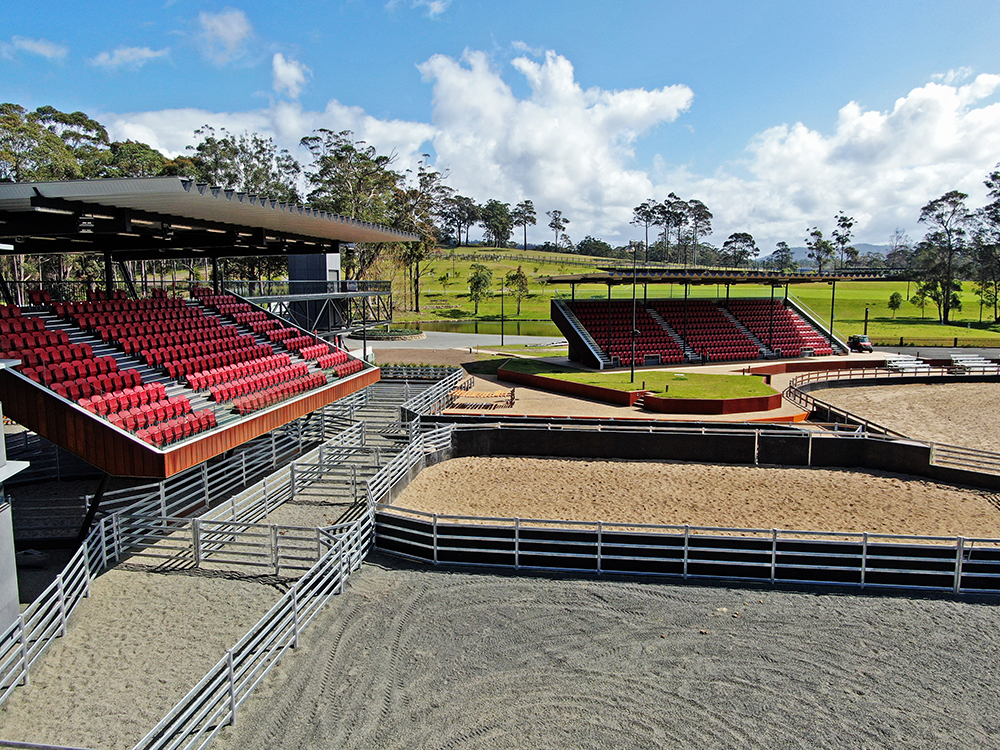
“When I look to pick a beast
to cut out… the breed is irrelevant.”

WILLINGA PARK’S WORLD CHAMPIONSHIP GOLD BUCKLE CAMPDRAFT
These competitions that started out selecting cattle from a rustic round pen and driven around three roughly-placed bush pegs have now become major events, with facilities that are far from rough and ready. A relatively new event to the campdraft scene, the Willinga Park World Championship Gold Buckle competition is beyond equestrian imagination and blows the Warwick Gold Cup out of the water in terms of prize money, with $286,000 on offer. And it is rapidly gaining in prestige as well.
There are 439 horses entered for the 2021 Volkswagen World Championship Gold Buckle Campdraft, with the competition staged over three days from 13-15 May. The age limit for riders is from 13 upwards! Classes start at 6am and go through until 9 or 10pm at night for the first two days, with all horses getting a run in the first two rounds. The final day sees 80 horses in the semi-final then 30 horses in the final — and what a final it will be. The winner is awarded the Gold Buckle valued at $8,000, plus $100,000 cash, as well as rugs and garlands. This makes the Willinga Park Gold Buckle Campdraft the richest in the world!
To run a campdraft is quite a feat and, given it is currently the fastest-growing equestrian sport in Australia, bigger and more modern facilities are really needed. With such huge money in this exciting, all-Australian sport, interest and sponsorship and horses needed for the sport are at a premium. And, of course, big prize money attracts great interest.
Terry and Ginette Snow, owners of the prestigious Willinga Park, have long been passionate about Stock Horses. Their passion started when Terry switched sports from sailing to horses and, loving the Stock Horse breed, riding, competing and breeding them followed as a consequence. Breeding Stock Horses leads to campdrafting competition, as that is where their prowess and niche lays.
Along with that comes the need for better and bigger facilities, and where better than at the fabulous Willinga Park. The work involved to run a competition like this is enormous. One of the most important elements for a good competition is the cattle. In the beginning at the country drafts, the cattle were brought in by locals to the camp. With a draft the size of the Gold Buckle, there are 1000 head required, all brought in from Terry and Ginette’s cattle properties.
On talking to past Gold Buckle champion Pete Comiskey about the cattle brought in for campdrafting competitions, it is enlightening to hear his views. “I don’t mind any breed of cattle. In the camp, when I look to pick a beast to cut out from the mob, the breed is irrelevant,” he says. “I rarely take any notice of that. It is one of those things that is hard to explain as to what I look for. It comes from years of experience.” He did start campdrafting when he was eight! “It’s a look in the eye and the face, it’s about attitude, it’s a feeling of confirmation that you get from experiencing so many runs.
“The problem with some cattle nowadays is that they are not as well handled in most cases. It’s not about having cattle that are fiery and want to run, it’s about having cattle that are confident and not worried by human and horse intervention. It’s about having cattle that are used to moving around the yards, that don’t run through gateways, that stay calm and are used to things going on around them. We don’t like seeing cattle in any way distressed by their surroundings, and of course their wellbeing is of the utmost for the sport and for us.
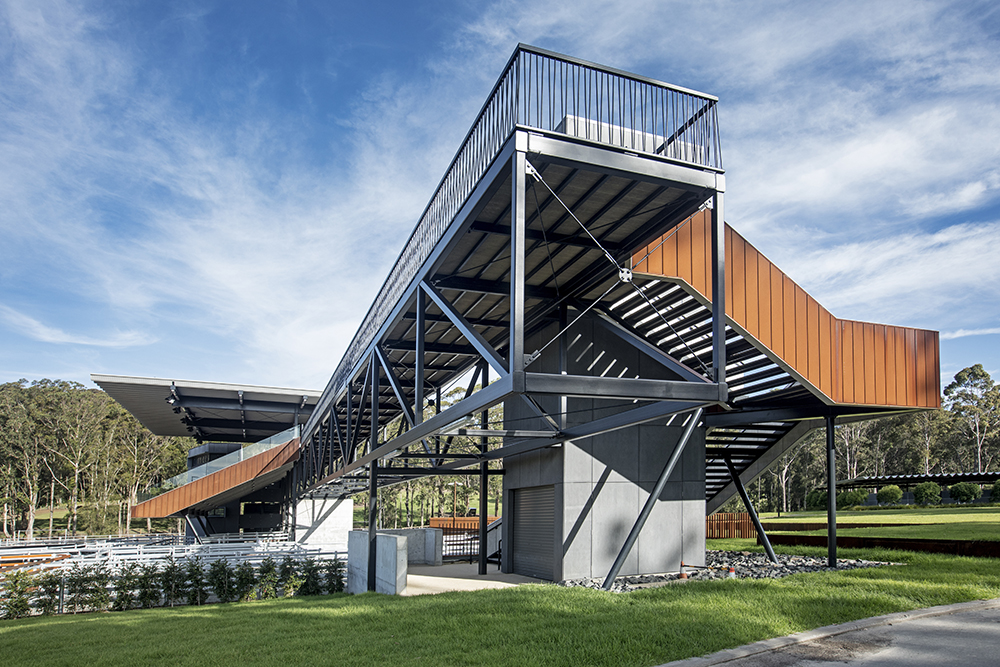

“If I had to say a breed that I may stay away from, it’s Murray Greys. Not sure why but it’s just one of those phenomena that I can’t explain. The cattle at Willinga are always great and very even in type and temperament and that’s not an easy thing to get with so many head required. At Willinga we have to thank Terry and the team for the privilege of the use of his 1000 head.”
The equestrian world ogles at Willinga Park’s amazing ebb-and-flow arenas specifically produced for Olympic level dressage and showjumping, the incredible recent addition of the cross country jumps that are a gain for the sport of eventing, and of course the indoor arena and the wonderful competition facilities — for not only the horses but the riders, owners and grooms. From heated swimming pools and luxurious apartments next to the best stabling complex, to the restaurants and cafes and bars, it’s simply the best.
Wait… the campdrafting facility is equal, if not better, and there is no other arena, pens or horse accommodation in Australia in the league of those at Willinga Park that can cater for so many top horses!
The huge circular campdraft arena is 89 metres in diameter with a perimeter of more than 300 metres, and has a sand and crushed granite surface over the entire 1.5 acres. The arena is flanked by trade stands, cafes and bars that are all elevated so that viewing from all places is premium. There are two stadiums, of which the newly completed one sits above the cattle yards and overlooks the cut-out (camp) yard. This is the only stand in Australia that allows the spectators a bird’s-eye view of the camp and that all-important part of the competition that is normally not able to be well viewed. It seats 350 people.
There are towers next to the stadium for judges and officials to sit with the best vantage point to judge from. The cattle yards are of the highest quality, being able to hold 500 cattle at a time, and then there are 170 timber-railed yards for the horses, along with a stable block of 40 for the stallions. There are also paddocks where competitors are able to make their own yards for their horses. The wonderful camping sites all have specific footing under the turf so that no matter what the weather there will be no risk of any size truck becoming bogged. Power and water are supplied to about 70 of these sites.
The foresight of Terry Snow in looking towards bigger and better competitions is exceptional and Willinga Park has to be seen to be believed. The atmosphere that exudes at the Gold Buckle is simply electrifying. Along with the competition, there is also a parade of 12 top Stock Horses from top breeders, so no doubt with amazing campdrafting and huge prize money available the knock-on effect will see huge prices for theses elite horses for sure. These 12 will be for sale in an online auction during the competition.
Each evening there will be a working dog (with cattle) competition as well as dressage demonstrations with Willinga Park horses ridden by Jayden Brown. There will be trick riders, Girls Girls, Girls, and a state-of-origin competition between NSW, ACT, Victoria and of course Queensland. Saturday night features a post-competition concert with country stars Adam Eckersley and Brooke McClymont entertaining. There will be guided bus tours going throughout the day taking visitors around the sculpture park, gardens the international Olympic equestrian facilities, not to mention the biggest Tesla power batteries and solar energy station in the southern hemisphere! The property is simply sensational and an absolute must to be seen. It even has its own water supply and sewerage!
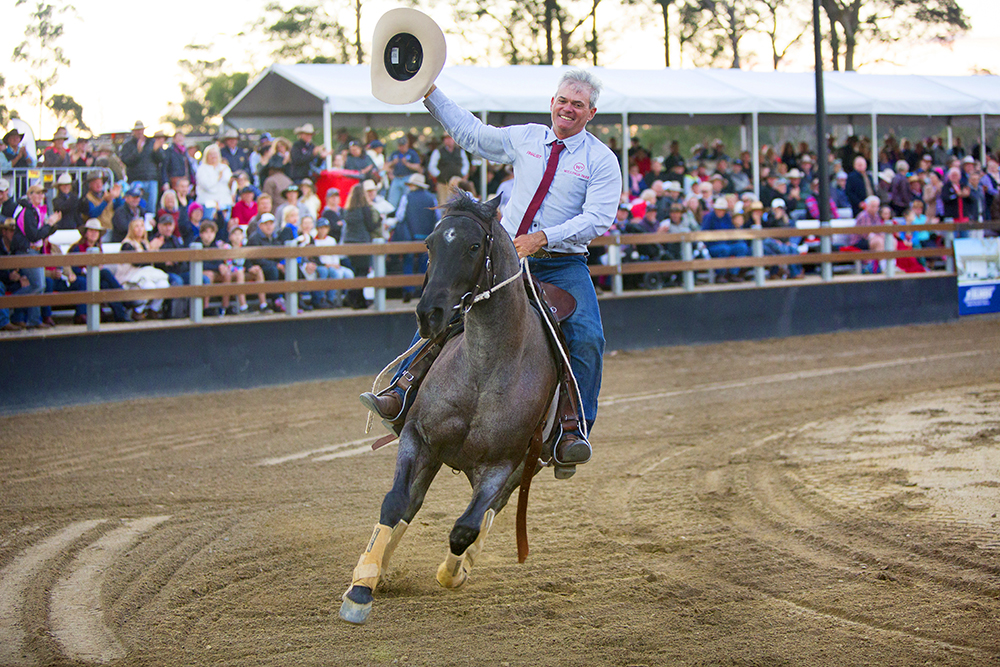
“You can never spend
enough time around cattle.”
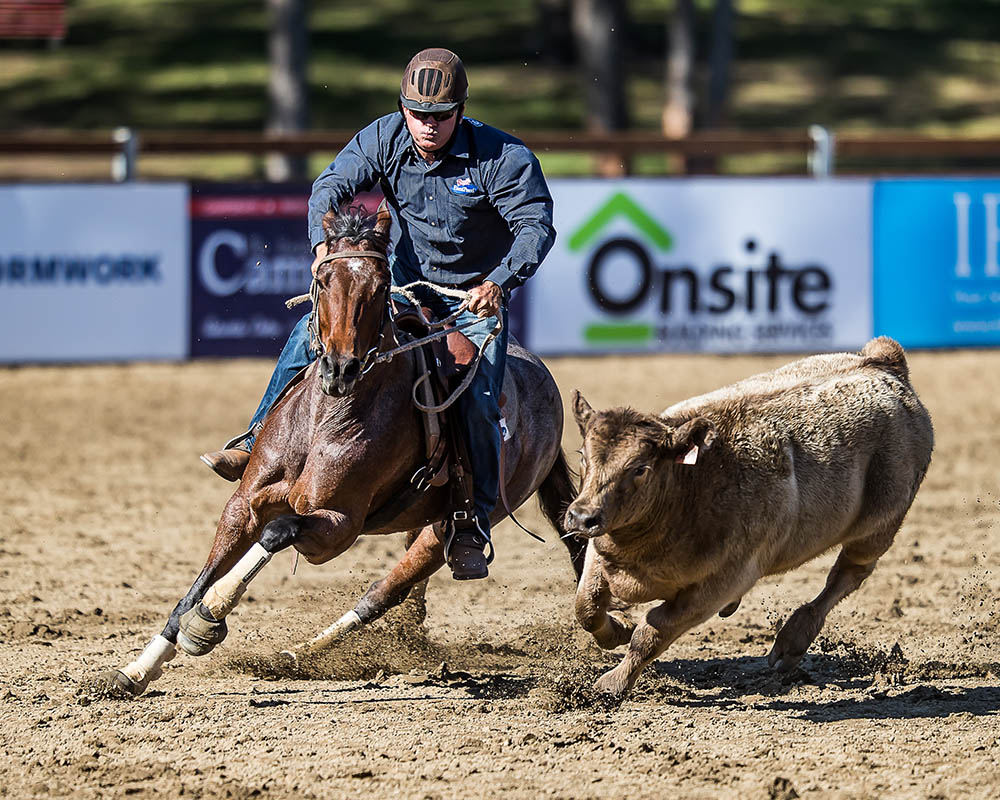
WILL PETE GET THE HAT TRICK?
Campdrafting in Australia is ever-growing and a sport that caters for all the family. It’s exciting to watch, and in a venue such as Willinga Park it is so Australian, modern and cultural yet still maintaining that great country atmosphere. For the last two years, the winner was Pete Comiskey. Quite a feat indeed and what an excellent horseman and cattleman he is. He makes man, horse and beast all look as if they are working as one. He is quite the consummate competitor.
In 2018, Pete won the inaugural Willinga Park World Championship Gold Buckle Campdraft with Rodann Roanies Destiny (aka Paris). The mare is by Quarter Horse stallion Acres Destiny out of star campdraft mare Rodann Roanies Chex. Remarkably, Pete defended his title in 2019 with Rodann Rip Off Chex (aka Brittany), a mare by the Australian Stock Horse stallion Hazelwood Conman, out of — you guessed it — Rodann Roanies Chex. The legendary Quarter Horse mare owned by Rodney and Anne Carpenter was an incredibly successful campdrafter, and as it turns out a superb broodmare.
Pete explains that Paris and Brittany were embryo transfer foals born at roughly the same time and given similar training. He believes that a strong mare line is the key to breeding a great horse, and this mare line through Rodann Roanies Chex is very dominant. “They are horses that can be trained, they’re very tough at competitions and I have a good relationship with them as well. I had so much success with the mother; it gives you a soft spot for the daughters as well. It’s quite a feat to have two (Gold Buckle winners) out of the same mare. Full credit to Rodney and Anne… this doesn’t happen overnight; they are genetics they have been working on for some 40 years.”
This year, Pete will be taking nine horses with him, and his wife, Bryony, will be competing in the ladies’ division and his son in the junior division. Pete is one hell of a horseman, but above that he is one hell of a great guy. His passion and enthusiasm are infectious and for such a talent and successful winner at so many top drafts he remains humble and encouraging to all who take an interest in the sport no matter what the level.
I ask Pete what was the main requisite to succeeding in the sport. “You can never spend enough time around cattle,” he says. “Mustering, poking around the yards, riding as much as you possibly can and watching experts training and working cattle. Sit and watch cattle in the yards and learn their ways. You have to be able to think like the cattle. You need an ability to anticipate what cattle are about to do and to read their next move, and you can only get this with experience and hours and hours in the saddle and working with them.
“I think it is really important to start with an experienced horse to help you learn the ropes. As for competing, take every opportunity to do clinics and watch the experts. There are classes to suit every level and age group. Take the chances as they come. Every day is a learned one and I know for sure that every day that goes by with horses and cattle I learn a little more.
“Of course, there has to be an element of luck with every run you make and I have to say that luck has been on my side of late and I hope it continues. I can’t wait to get to Willinga. Having won the Gold Buckle twice with my two mares has been a serious highlight and I will certainly be out trying again. One thing for sure is that win, lose or draw we will all have a fantastic time. Who wouldn’t at such an amazing facility?” EQ

